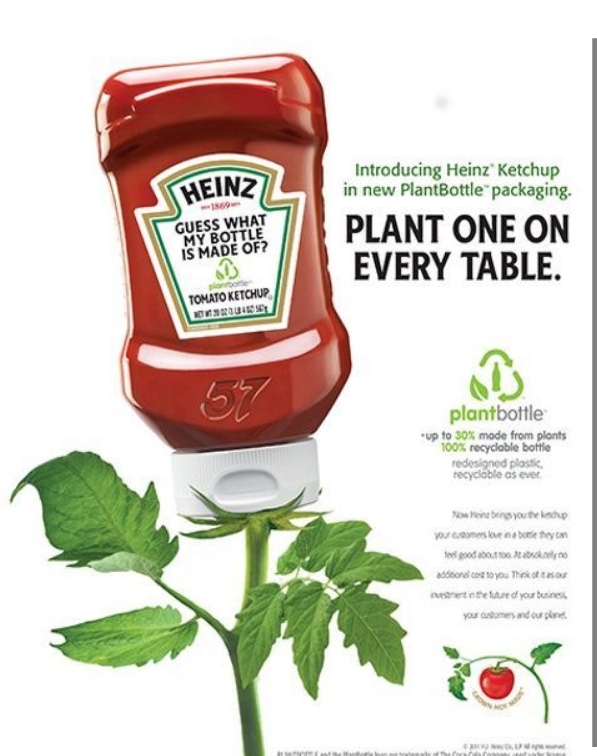This advertisement from Heinz was made to promote plant-based packaging for ketchup. This still image advertisement shows a photorealistic composite image of a plant-based bottle of ketchup emerging from a plant stem evoking a fresh tomato. The image is minimalist with no background, drawing all attention to the vibrant singular image. The composition of the ad is simple – the image takes up the center and left of the image with all text to the right. It is entirely colored red and green; the red simply being the color of tomatoes and ketchup, while the green symbolizes nature, plants, and eco-consciousness. The Heinz bottle is glossy with white highlights, depicting it as something pristine and unblemished.
The advertisement aims to portray Heinz tomato ketchup as fresh and natural to an environmentally aware public, and I believe this advertisement would prove successful. Given that Heinz ketchup is similarly priced to competitors, this eco-friendly advertisement could easily sway the average consumer. The advertisement leaves me with a lukewarm impression as, while I do not personally buy into the fresh tomato aspect of the advertisement, I would be more likely to purchase from a brand that is attempting to reduce negative impact on the ecosystem. Although the advertisement comes across less than genuine and a touch greenwashed, I would prefer it over another company that is not making any effort at all.
Considering the ubiquity of Kraft-Heinz as a brand and as a company, it comes as no surprise that many others have weighed in on the topic of their sustainability practices. Shortly after the company’s humble inception in 1869, one man selling horseradish locally, the company ballooned in size thanks to its powerful brand recognition and quickly became one of the leading foodstuff manufacturers in America. With this increase in scope came an increase in manufacturing, with multiple factories producing upwards of 20,000 cans per day by 1875. These factories arose during a time of lacking regulation and environmental awareness and were therefore rampant with the unnecessary fuel emissions and environmental shortcuts omnipresent in industrial era production.1
In 2020, sustainability news website “Edie” criticized Heinz’s failures while using a CSR (Corporate Social Responsibility) model to evaluate their environmental impact and hoped that Heinz’s at the time upcoming shift to an ESG (Environmental Social Governance) system would prove more effective. During the period of time Heinz used the CSR system they failed to make improvements for the company and harmful byproducts of manufacturing such as fuel emissions and high energy consumption counter-intuitively increased. The advertisement I have chosen comes from this period of CSR evaluation, and I believe falls in line with this less than effective model.2
On a positive note, a more recent critique from Sustainability magazine, done in 2022, shows that Heinz’s green practices may genuinely be improving. The company’s established goal is to have 100% recyclable or compostable packaging by 2025 and at the time of this article had achieved 85%. They also had net zero greenhouse gas emissions and reduced the amount of waste they added to landfills by 15%. Being a massive corporation that moves millions of products, these reductions may be a drop in the bucket, but they are still significant improvements and show that their new ESG system may continue to prove effective.


Berea Woldeyes
I really appreciated this analysis by Carson. Their Heinz advertisement was interesting and visually appealing to our class’s greenwashing goal. I think the advertisement description was one of the most successful factors of their analysis. Carson was able to critically analyze the aspects of the advertisement that cover how Heinz’s ketchup is “environmentally aware” and eco-friendly. Carson used adjectives to describe the ad such as “photorealistic” and “fresh” which I think were great words selected to represent their advertisement.
Carson’s main points from the Heinz ketchup bottle advertisement were:
1. Heinz’s advertisement was successful in their portrayal of their eco-friendly ketchup bottles.
2. This advertisement in particular could sway the average consumer to buy Heinz over other competitors.
3. According to Carson’s scholarly sources, Heinz’s green practices seem to have significantly improved over the past few years.
I have little feedback when it comes to improving their analysis other than suggesting to potentially clarify their CSR paragraph. It took me quite a while to understand how this paragraph related to their analysis. The concluding sentence of that paragraph (“The advertisement I have chosen comes from this period of CSR evaluation, and I believe falls in line with this less than effective model”) I believe maybe could have been simplified and reworded better for an audience like myself to understand.
Overall I enjoyed learning about Heinz’s history and their eco-friendly advertisement!